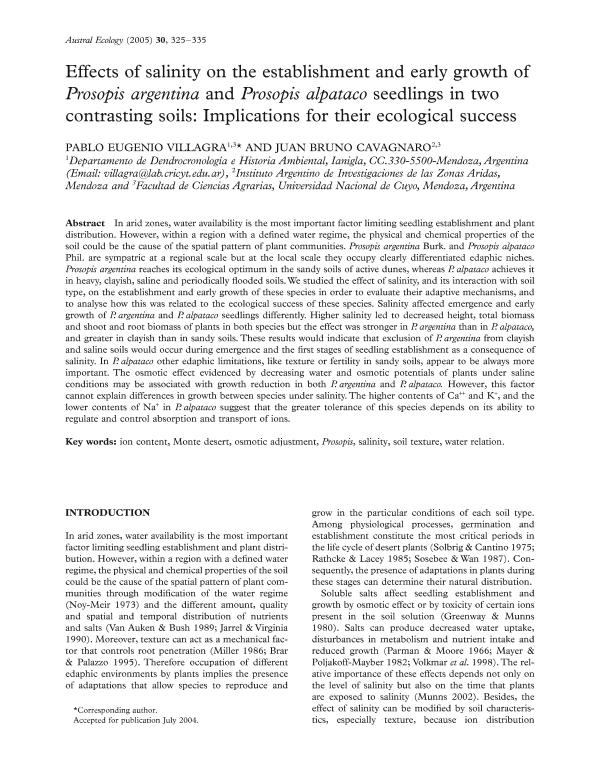Mostrar el registro sencillo del ítem
dc.contributor.author
Villagra, Pablo Eugenio

dc.contributor.author
Cavagnaro, Juan Bruno

dc.date.available
2020-09-03T19:50:23Z
dc.date.issued
2005-12
dc.identifier.citation
Villagra, Pablo Eugenio; Cavagnaro, Juan Bruno; Effects of salinity on the establishment and early growth of Prosopis argentina and Prosopis alpataco seedlings in two contrasting soils: Implications for their ecological success; Wiley Blackwell Publishing, Inc; Austral Ecology; 30; 3; 12-2005; 325-335
dc.identifier.issn
1442-9985
dc.identifier.uri
http://hdl.handle.net/11336/113170
dc.description.abstract
In arid zones, water availability is the most important factor limiting seedling establishment and plant distribution. However, within a region with a defined water regime, the physical and chemical properties of the soil could be the cause of the spatial pattern of plant communities. Prosopis argentina Burk. and Prosopis alpataco Phil. are sympatric at a regional scale but at the local scale they occupy clearly differentiated edaphic niches. Prosopis argentina reaches its ecological optimum in the sandy soils of active dunes, whereas P. alpataco achieves it in heavy, clayish, saline and periodically flooded soils. We studied the effect of salinity, and its interaction with soil type, on the establishment and early growth of these species in order to evaluate their adaptive mechanisms, and to analyse how this was related to the ecological success of these species. Salinity affected emergence and early growth of P. argentina and P. alpataco seedlings differently. Higher salinity led to decreased height, total biomass and shoot and root biomass of plants in both species but the effect was stronger in P. argentina than in P. alpataco, and greater in clayish than in sandy soils. These results would indicate that exclusion of P. argentina from clayish and saline soils would occur during emergence and the first stages of seedling establishment as a consequence of salinity. In P. alpataco other edaphic limitations, like texture or fertility in sandy soils, appear to be always more important. The osmotic effect evidenced by decreasing water and osmotic potentials of plants under saline conditions may be associated with growth reduction in both P. argentina and P. alpataco. However, this factor cannot explain differences in growth between species under salinity. The higher contents of Ca++ and K+, and the lower contents of Na + in P. alpataco suggest that the greater tolerance of this species depends on its ability to regulate and control absorption and transport of ions.Prosopis argentina Burk. and Prosopis alpataco Phil. are sympatric at a regional scale but at the local scale they occupy clearly differentiated edaphic niches. Prosopis argentina reaches its ecological optimum in the sandy soils of active dunes, whereas P. alpataco achieves it in heavy, clayish, saline and periodically flooded soils. We studied the effect of salinity, and its interaction with soil type, on the establishment and early growth of these species in order to evaluate their adaptive mechanisms, and to analyse how this was related to the ecological success of these species. Salinity affected emergence and early growth of P. argentina and P. alpataco seedlings differently. Higher salinity led to decreased height, total biomass and shoot and root biomass of plants in both species but the effect was stronger in P. argentina than in P. alpataco, and greater in clayish than in sandy soils. These results would indicate that exclusion of P. argentina from clayish and saline soils would occur during emergence and the first stages of seedling establishment as a consequence of salinity. In P. alpataco other edaphic limitations, like texture or fertility in sandy soils, appear to be always more important. The osmotic effect evidenced by decreasing water and osmotic potentials of plants under saline conditions may be associated with growth reduction in both P. argentina and P. alpataco. However, this factor cannot explain differences in growth between species under salinity. The higher contents of Ca++ and K+, and the lower contents of Na + in P. alpataco suggest that the greater tolerance of this species depends on its ability to regulate and control absorption and transport of ions.
dc.format
application/pdf
dc.language.iso
eng
dc.publisher
Wiley Blackwell Publishing, Inc

dc.rights
info:eu-repo/semantics/openAccess
dc.rights.uri
https://creativecommons.org/licenses/by-nc-sa/2.5/ar/
dc.subject
ION CONTENT
dc.subject
MONTE DESERT
dc.subject
OSMOTIC ADJUSTMENT
dc.subject
PROSOPIS
dc.subject
SALINITY
dc.subject
SOIL TEXTURE
dc.subject
WATER RELATION
dc.subject.classification
Silvicultura

dc.subject.classification
Agricultura, Silvicultura y Pesca

dc.subject.classification
CIENCIAS AGRÍCOLAS

dc.title
Effects of salinity on the establishment and early growth of Prosopis argentina and Prosopis alpataco seedlings in two contrasting soils: Implications for their ecological success
dc.type
info:eu-repo/semantics/article
dc.type
info:ar-repo/semantics/artículo
dc.type
info:eu-repo/semantics/publishedVersion
dc.date.updated
2020-08-04T19:40:12Z
dc.journal.volume
30
dc.journal.number
3
dc.journal.pagination
325-335
dc.journal.pais
Reino Unido

dc.journal.ciudad
Londres
dc.description.fil
Fil: Villagra, Pablo Eugenio. Consejo Nacional de Investigaciones Científicas y Técnicas. Centro Científico Tecnológico Conicet - Mendoza. Instituto Argentino de Nivología, Glaciología y Ciencias Ambientales. Museo de Historia Natural de San Rafael - Ianigla | Provincia de Mendoza. Instituto Argentino de Nivología, Glaciología y Ciencias Ambientales. Museo de Historia Natural de San Rafael - Ianigla | Universidad Nacional de Cuyo. Instituto Argentino de Nivología, Glaciología y Ciencias Ambientales. Museo de Historia Natural de San Rafael - Ianigla; Argentina
dc.description.fil
Fil: Cavagnaro, Juan Bruno. Consejo Nacional de Investigaciones Científicas y Técnicas. Centro Científico Tecnológico Conicet - Mendoza. Instituto Argentino de Investigaciones de las Zonas Áridas. Provincia de Mendoza. Instituto Argentino de Investigaciones de las Zonas Áridas. Universidad Nacional de Cuyo. Instituto Argentino de Investigaciones de las Zonas Áridas; Argentina
dc.journal.title
Austral Ecology

dc.relation.alternativeid
info:eu-repo/semantics/altIdentifier/doi/https://doi.org/10.1111/j.1442-9993.2005.01477.x
dc.relation.alternativeid
info:eu-repo/semantics/altIdentifier/url/https://onlinelibrary.wiley.com/doi/abs/10.1111/j.1442-9993.2005.01477.x
Archivos asociados
